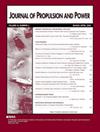Dynamic Regulation Process of the Variable-Geometry Power Turbine
IF 2.4
4区 工程技术
Q2 ENGINEERING, AEROSPACE
引用次数: 0
Abstract
In this paper, the dynamic regulating process of a variable-geometry power turbine is investigated through wind-tunnel experiments. Particle image velocimetry is used to obtain the dynamic evolution of the flowfield in the cascade passage, including two adjustment processes of increasing and decreasing the throat area. During the test, snapshots of the clockwise/counterclockwise rotation of a blade in the range of [Formula: see text] to [Formula: see text] are processed with a piecewise time-averaged method. The results indicate that the macroscopic change in the flowfield structure mainly appears in the wake region and the high-velocity region. In this process, the velocity and flow angle change monotonously with the blade rotation. The change rate of velocity is determined by both the blade position and the dimensionless outlet location [Formula: see text]. The overall change rate of velocity when the blade approaches the design position is higher than that at other positions, and the airflow near the suction surface is more sensitive to the adjustment of the cascade geometry compared with that near the pressure surface. As for the flow angle, the specific value is mainly determined by the blade position, and the variation law is related to the blade rotation speed.变几何动力涡轮机的动态调节过程
本文通过风洞试验研究了变几何动力涡轮机的动态调节过程。利用粒子图像测速技术获得叶栅通道内流场的动态演化,包括增加和减少喉部面积两个调节过程。在测试过程中,采用分段时间平均法处理[公式:见正文]至[公式:参见正文]范围内叶片顺时针/逆时针旋转的快照。结果表明,流场结构的宏观变化主要出现在尾流区和高速区。在这个过程中,速度和流动角度随着叶片的旋转而单调变化。速度的变化率由叶片位置和无量纲出口位置决定[公式:见正文]。当叶片接近设计位置时,速度的总体变化率高于其他位置,并且与压力面附近相比,吸力面附近的气流对叶栅几何形状的调整更敏感。至于流动角度,具体值主要由叶片位置决定,变化规律与叶片转速有关。
本文章由计算机程序翻译,如有差异,请以英文原文为准。
求助全文
约1分钟内获得全文
求助全文
来源期刊

Journal of Propulsion and Power
工程技术-工程:宇航
CiteScore
4.20
自引率
21.10%
发文量
97
审稿时长
6.5 months
期刊介绍:
This Journal is devoted to the advancement of the science and technology of aerospace propulsion and power through the dissemination of original archival papers contributing to advancements in airbreathing, electric, and advanced propulsion; solid and liquid rockets; fuels and propellants; power generation and conversion for aerospace vehicles; and the application of aerospace science and technology to terrestrial energy devices and systems. It is intended to provide readers of the Journal, with primary interests in propulsion and power, access to papers spanning the range from research through development to applications. Papers in these disciplines and the sciences of combustion, fluid mechanics, and solid mechanics as directly related to propulsion and power are solicited.
 求助内容:
求助内容: 应助结果提醒方式:
应助结果提醒方式:


